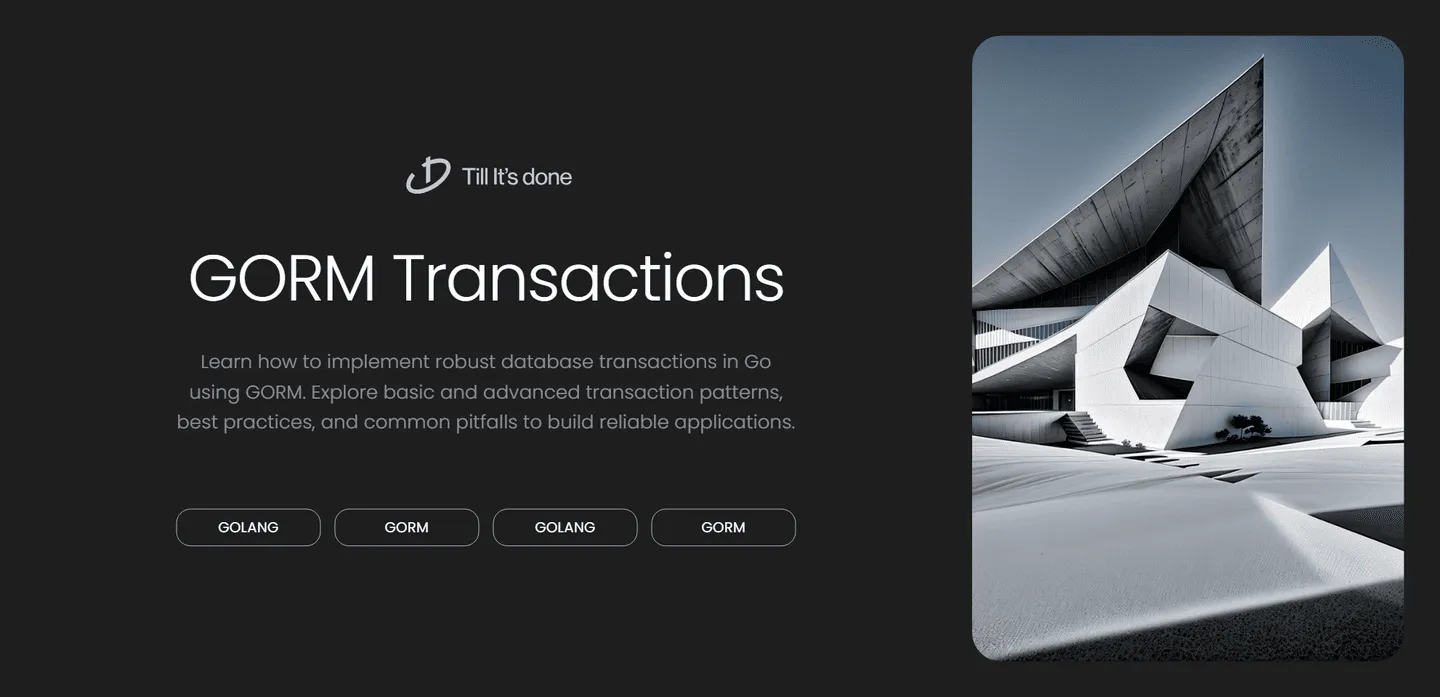- Services
- Case Studies
- Technologies
- NextJs development
- Flutter development
- NodeJs development
- ReactJs development
- About
- Contact
- Tools
- Blogs
- FAQ
Master Database Transactions with GORM
Explore basic and advanced transaction patterns, best practices, and common pitfalls to build reliable applications.

A Comprehensive Guide to Transactions in GORM

Database transactions are crucial for maintaining data integrity in modern applications. When working with Go and GORM, understanding how to properly implement transactions can make the difference between a robust application and one prone to data inconsistencies. Let’s dive deep into GORM transactions and explore their practical applications.
Understanding Transactions in GORM
Transactions ensure that a series of database operations either complete successfully as a single unit or fail entirely, leaving the database unchanged. Think of it as an all-or-nothing operation – perfect for scenarios where data consistency is paramount.

Basic Transaction Usage
GORM provides several ways to work with transactions. Let’s explore each approach with practical examples.
Method 1: Transaction Blocks
func CreateOrder(db *gorm.DB) error { return db.Transaction(func(tx *gorm.DB) error { order := Order{ UserID: 1, Items: []Item{ {ProductID: 1, Quantity: 2}, {ProductID: 2, Quantity: 1}, }, }
if err := tx.Create(&order).Error; err != nil { return err }
// Update inventory if err := tx.Model(&Product{}). Where("id = ?", 1). Update("stock", gorm.Expr("stock - ?", 2)).Error; err != nil { return err }
return nil })}Method 2: Manual Transaction Management
func ProcessPayment(db *gorm.DB) error { tx := db.Begin()
defer func() { if r := recover(); r != nil { tx.Rollback() } }()
if err := tx.Error; err != nil { return err }
// Perform operations if err := tx.Create(&Payment{Amount: 100}).Error; err != nil { tx.Rollback() return err }
return tx.Commit().Error}
Advanced Transaction Patterns
Nested Transactions
While GORM doesn’t support true nested transactions, it provides SavePoint functionality:
func ComplexOperation(db *gorm.DB) error { return db.Transaction(func(tx *gorm.DB) error { // Main transaction operations if err := tx.Create(&MainRecord{}).Error; err != nil { return err }
// Savepoint tx.SavePoint("before_nested")
if err := riskyOperation(tx); err != nil { tx.RollbackTo("before_nested") // Continue with other operations }
return nil })}Transaction Hooks
GORM allows you to register callbacks for transaction events:
db.Callback().Create().After("gorm:create").Register("after_create", func(db *gorm.DB) { if db.Statement.Table == "users" { // Perform additional operations after user creation }})Best Practices and Common Pitfalls
- Always use transactions for operations that modify multiple records
- Keep transactions as short as possible to avoid long-running locks
- Handle errors properly and ensure proper rollback
- Be cautious with external API calls within transactions
- Use appropriate isolation levels for your use case
When to Use Transactions
- Payment processing
- Order management
- User registration with related records
- Inventory management
- Data migration operations

Remember that while transactions provide data consistency, they come with performance overhead. Use them judiciously and always test your transaction logic thoroughly in a staging environment before deploying to production.
 สร้างเว็บไซต์ 1 เว็บ ต้องใช้งบเท่าไหร่? เจาะลึกทุกองค์ประกอบ website development cost อยากสร้างเว็บไซต์แต่ไม่มั่นใจในเรื่องของงบประมาณ อ่านสรุปเจาะลึกตั้งแต่ดีไซน์, ฟังก์ชัน และการดูแล พร้อมตัวอย่างงบจริงจาก Till it’s done ที่แผนชัด งบไม่บานปลายแน่นอน
สร้างเว็บไซต์ 1 เว็บ ต้องใช้งบเท่าไหร่? เจาะลึกทุกองค์ประกอบ website development cost อยากสร้างเว็บไซต์แต่ไม่มั่นใจในเรื่องของงบประมาณ อ่านสรุปเจาะลึกตั้งแต่ดีไซน์, ฟังก์ชัน และการดูแล พร้อมตัวอย่างงบจริงจาก Till it’s done ที่แผนชัด งบไม่บานปลายแน่นอน  Next.js สอน 14 ขั้นตอนเบื้องต้น: สร้างโปรเจกต์แรกใน 30 นาที เริ่มต้นกับ Next.js ใน 14 ขั้นตอนเพียงแค่ 30 นาที พร้อม SSR/SSG และ API Routes ด้วยตัวอย่างโค้ดง่าย ๆ อ่านต่อเพื่อสร้างโปรเจ็กต์แรกได้ทันทีที่นี่
Next.js สอน 14 ขั้นตอนเบื้องต้น: สร้างโปรเจกต์แรกใน 30 นาที เริ่มต้นกับ Next.js ใน 14 ขั้นตอนเพียงแค่ 30 นาที พร้อม SSR/SSG และ API Routes ด้วยตัวอย่างโค้ดง่าย ๆ อ่านต่อเพื่อสร้างโปรเจ็กต์แรกได้ทันทีที่นี่  วิธีสมัคร Apple Developer Account เพื่อนำแอปขึ้น App Store ทีละขั้นตอน อยากปล่อยแอปบน App Store ระดับโลก มาอ่านคู่มือสมัคร Apple Developer Account พร้อมเคล็ดลับ TestFlight และวิธีอัปโหลดที่ง่ายในบทความเดียวนี้ได้เลย
วิธีสมัคร Apple Developer Account เพื่อนำแอปขึ้น App Store ทีละขั้นตอน อยากปล่อยแอปบน App Store ระดับโลก มาอ่านคู่มือสมัคร Apple Developer Account พร้อมเคล็ดลับ TestFlight และวิธีอัปโหลดที่ง่ายในบทความเดียวนี้ได้เลย  TypeScript Interface คืออะไร? อธิบายพร้อมวิธีใช้และข้อแตกต่างจาก Type เรียนรู้วิธีใช้ TypeScript Interface เพื่อสร้างโครงสร้างข้อมูลที่ปลอดภัยและเข้าใจง่าย พร้อมเปรียบเทียบข้อดีข้อแตกต่างกับ Type ที่คุณต้องรู้ ถูกรวมเอาไว้ในบทความนี้แล้ว
TypeScript Interface คืออะไร? อธิบายพร้อมวิธีใช้และข้อแตกต่างจาก Type เรียนรู้วิธีใช้ TypeScript Interface เพื่อสร้างโครงสร้างข้อมูลที่ปลอดภัยและเข้าใจง่าย พร้อมเปรียบเทียบข้อดีข้อแตกต่างกับ Type ที่คุณต้องรู้ ถูกรวมเอาไว้ในบทความนี้แล้ว  Material-UI (MUI) คืออะไร อยากสร้าง UI สวยงามและเป็นมืออาชีพในเวลาอันรวดเร็วใช่ไหม มาทำความรู้จักกับ Material-UI (MUI) ที่ช่วยให้คุณพัฒนาแอปพลิเคชันบน React ได้ง่ายและดูดีในทุกอุปกรณ์
Material-UI (MUI) คืออะไร อยากสร้าง UI สวยงามและเป็นมืออาชีพในเวลาอันรวดเร็วใช่ไหม มาทำความรู้จักกับ Material-UI (MUI) ที่ช่วยให้คุณพัฒนาแอปพลิเคชันบน React ได้ง่ายและดูดีในทุกอุปกรณ์  เปรียบเทียบ 3 วิธีติดตั้ง install node js บน Ubuntu: NVM vs NodeSource vs Official Repo แบบไหนดีที่สุด? เรียนรู้วิธีติดตั้ง Node.js บน Ubuntu ด้วย NVM, NodeSource หรือ Official Repo เลือกวิธีที่เหมาะกับความต้องการของคุณ พร้อมเปรียบเทียบ เพื่อการพัฒนาที่มีประสิทธิภาพ!
เปรียบเทียบ 3 วิธีติดตั้ง install node js บน Ubuntu: NVM vs NodeSource vs Official Repo แบบไหนดีที่สุด? เรียนรู้วิธีติดตั้ง Node.js บน Ubuntu ด้วย NVM, NodeSource หรือ Official Repo เลือกวิธีที่เหมาะกับความต้องการของคุณ พร้อมเปรียบเทียบ เพื่อการพัฒนาที่มีประสิทธิภาพ! Talk with CEO
We'll be right here with you every step of the way.
We'll be here, prepared to commence this promising collaboration.
Whether you're curious about features, warranties, or shopping policies, we provide comprehensive answers to assist you.


